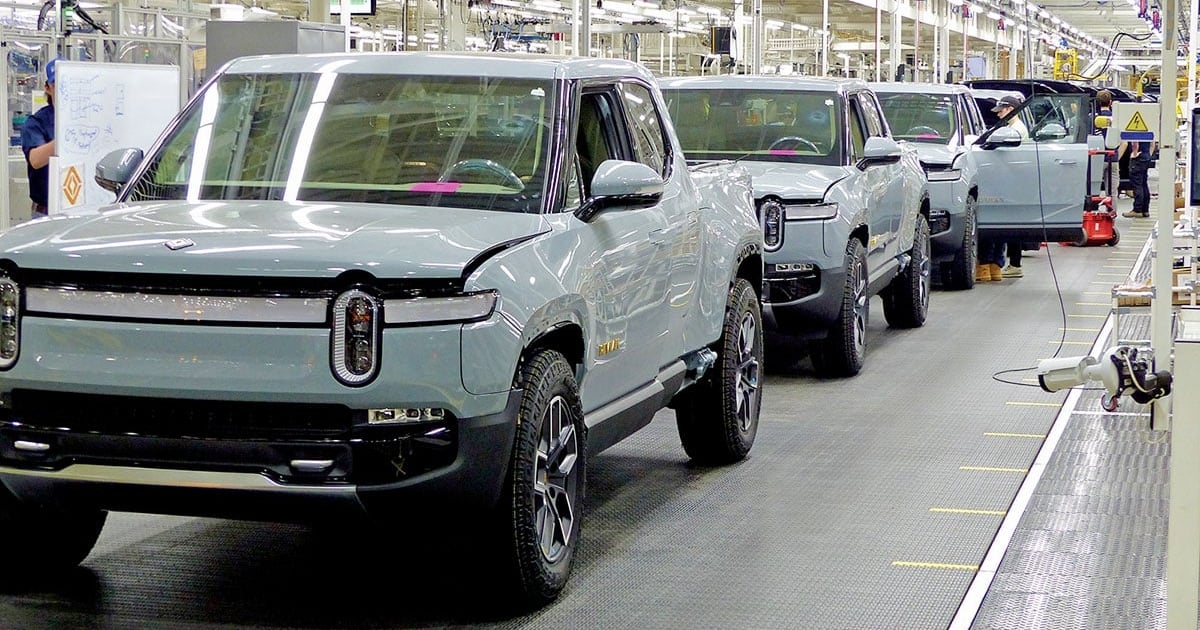
Rivian Automotive expects to meet its 50,000 production goal this year as it implements factory upgrades that will both increase output and reduce costs in the coming months, the company said after posting a $1.35 billion first-quarter net loss.
The EV startup assembled just 9,395 vehicles in the first quarter, including the R1T pickup, R1S crossover and EDV commercial vans.
Rivian paused van output in the first-quarter to introduce its in-house Enduro motor and an iron-based battery pack to the van line.
“Production in the first quarter was in-line with our expectations and, as a result, we are re-affirming our production outlook for the year of 50,000 total units,” CEO RJ Scaringe said on the first-quarter earnings call Tuesday.
The industry newcomer posted revenue of $661 million for the quarter, which beat Wall Street estimates. Rivian’s share price rose about 5 percent in after-hours trading.
While Rivian continues to burn through cash, the company suggested it’s starting to turn the corner in terms of solving production bottlenecks and cutting costs. A big first step comes from using its own Enduro motor, first in EDV vans and later this quarter in the R1T and R1S.
“Enduro’s providing cost improvements that will result in a significant reduction in our bill of materials,” Scaringe said.
The costs of materials for EDV vans fell by 25 percent through the introduction of the Enduro electric motor and lithium-iron-phosphate battery packs. Previously, Rivian was using an outsourced motor and more expensive nickel-based battery cells in the vans.
While its consumer vehicles won’t receive the LFP packs immediately, about half of all R1 vehicles are expected to use the Enduro motor later this year, Scaringe said. The third-party motors will continue to be used on the other half.
One reason why Rivian has been posting large net losses quarter after quarter is because it is making a relatively small number of vehicles in a plant designed for up to 150,000 a year. The automaker’s fixed costs are not being offset by stronger sales and income.
“Growing production volume improves fixed-cost leverage at our large-scale manufacturing plant in Normal, Ill.,” Scaringe said.
The goal, he added, is to reach profitability through the combination of production gains and cost cutting. Rivian is negotiating lower costs with its suppliers, he said.
Additionally, Rivian is building that cost savings into its next-generation R2 platform, which is now in development, Scaringe said. The future R2 vehicles, which will carry lower sticker prices, will be built at a future plant in Georgia starting in 2026.
The R1T starts at $74,800 with shipping.
Rivian declined to disclose its order backlog on the Tuesday earnings call.
The last time it released order numbers, in November 2022, the automaker said it had 114,000 preorders in the U.S. and Canada for the R1T pickup and R1S crossover, plus a long-term order from Amazon for 100,000 EDV delivery vans.
Rivian reported a net loss of $1.35 billion for the first three months of the year, compared with a loss of $1.59 billion in the same quarter last year.
Revenue for the quarter ended March 31 stood at $661 million, compared with Wall Street estimates of $652 million, according to Refinitiv data.
Cash and cash equivalents at the end of the first quarter were $11.24 billion, compared with $11.57 billion, in the preceding three-month period, Reuters said.
Rivian CFO Claire McDonough said the company has enough cash to take it through 2025.
In response to a question on the earnings call, Scaringe said he doesn’t anticipate price cuts to R1 consumer vehicles in order to match cuts by other EV makers in the market. Rather, Rivian will have future trims that are both more expensive and less expensive than current ones.
Rivian expects to introduce the less expensive LFP battery pack to its consumer vehicles in the near future along with a more expensive extended-range pack, the company has said, without disclosing timing.

